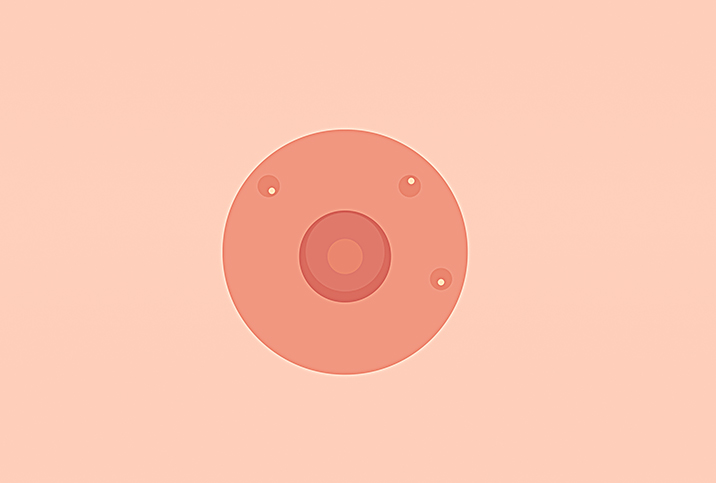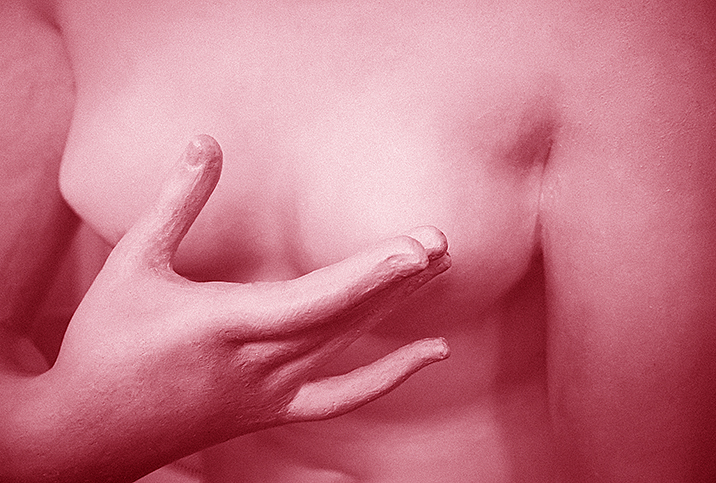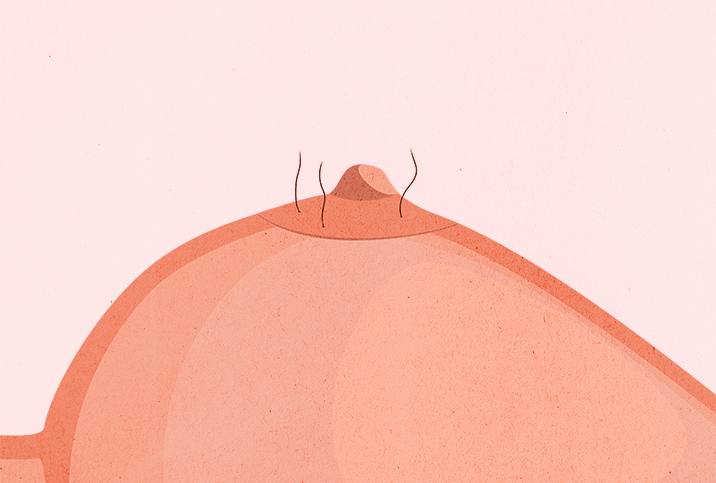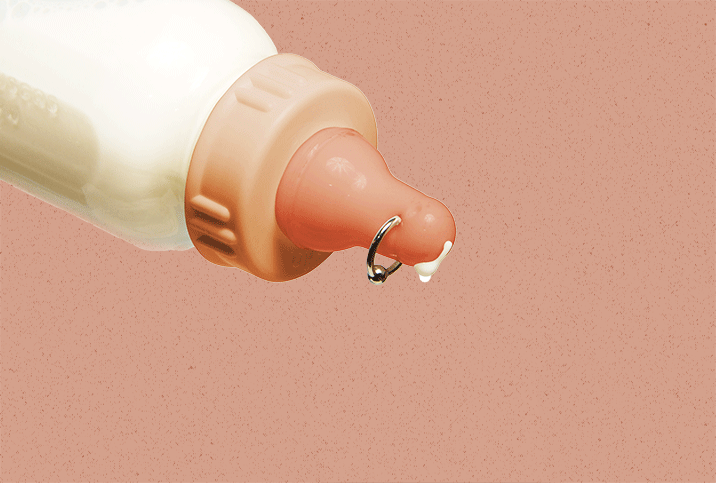WTF Are All These Weird Bumps on My Nipples?
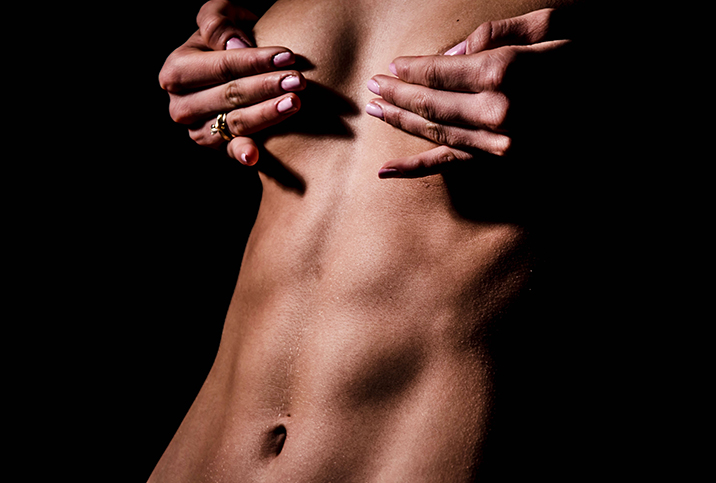
Once you've cleared that awkward teenage phase, discovering zits pretty much anywhere on your body can ruin your day. Spotting one on your breast? That's not particularly ideal.
Breasts, the tissue overlying the pectoral muscles, are made of glandular tissue (which produces milk) and fatty tissue (that's what determines how large they are). The nipple is the part of your breast that sticks out, where milk secretes during breastfeeding. That circle with pigmented skin around the nipple? That's the areola.
Finding a variance of texture on all three of these areas can be totally natural, especially as females grow older, as hormones fluctuate (such as when birth control is prescribed or for women going through menopause), and during pregnancy.
These factors contribute to changes in the size, shape and tissue density of your breasts. No breast, nipple or areola looks the same forever. When you find something strange near or on your breast, it's usually harmless—but at first glance, it may cause some alarm.
Are small bumps on my breasts pimples?
Certain circumstances—wearing restrictive clothing during a workout or hormonal fluctuations during menstruation—can bring on a bout of chest acne that may pop up on your nipples, said Amie Sessa, M.D., a dermatologist in Lutherville, Maryland.
Considering that this part of your body is almost always covered, it's easy for sweat, oil and dirt to build up in areolar glands, a type of sebaceous gland that produces oil and sebum meant to lubricate the skin. When these glands get clogged and infected, pimple-like bumps can form.
"Most of these glands are concentrated on the face, but they can overgrow in several areas of the skin, including the areola," Sessa explained.
But for the majority of people, raised textures on the areola are not pimples.
What are the bumps all over my areola?
If you notice a handful of bumps scattered specifically on your areola, those may be Montgomery tubercles, a combination of milk glands and sebaceous glands named for the 19th-century Irish obstetrician who claimed to discover them. These bumps are considered protective, as they keep germs away from the breast and protect the nipple from infection.
"I've had these whitish-colored bumps around my areola since I started puberty at 13," said Anna, 31, a North Carolina-based artist. "I never considered them an issue or a problem. They've never been aggravated, and I've never had a partner comment on them looking different."
When Anna became pregnant two years ago, she said she noticed those bumps growing slightly. That's normal: During pregnancy, breasts change. The areola and veins darken, breasts become more tender and swollen, and the Montgomery glands enlarge. The reasons are connected to breastfeeding, as babies are attracted to the scent that the glands produce to encourage the baby to latch on to the nipple, according to a 2009 study in PLoS One.
What is the painful bump on my areola?
While Montgomery glands are scattered along the areola, a rogue and irritated bump may be an ingrown hair. The human body is covered in peach fuzz hair, and boobs are no different—some people may have a sprinkling of wiry hairs on their areola that are completely natural and harmless.
But when a follicle is blocked anywhere on the body, it forces hair to grow sideways back into the skin. Not ideal, but don't dig them out, since breaking the skin can open you up to a risk of infection, Sessa said. Instead, use a warm compress to soften the area around the follicle and then try to pull out the hair.
"If they're becoming bothersome or occurring regularly, see your dermatologist for topical or oral treatment options," Sessa added.
What if I'm breastfeeding and have a painful bump?
For people who are breastfeeding, a blocked nipple pore may contribute to something called a milk blister, which is basically milk trapped under the skin when growth occurs over the milk duct. This type of singular bump happens right on the nipple, usually has a white or pink tip and can be very painful, explained Stephanie Brown, a Philadelphia-based lactation consultant. They can be very persistent and remain for days or weeks until the skin naturally peels away.
Soaking the nipple with warm salt water just before a nursing session usually remedies the problem, she noted—but, if these blisters are left untreated, it can lead to a clogged duct, which can spiral into more serious health issues.
Can a bump on my nipples be breast cancer?
A breast lump is typically found inside your breast tissue, not on the outside. However, a bump can be a sign of a different problem. Paget's disease is a rare inflammatory breast cancer that causes an ulcer to form on your nipple and branch out to the areola. It is not the same thing as Paget's disease of the bone, noted the Mayo Clinic.
If you are experiencing breast pain or other breast change, those could be symptoms of breast cancer. Variations in shape and texture and nipple discharge could be a symptom of something else. Contact your doctor for peace of mind.
The bottom line
Most of the time, these bumps are a natural, non-concerning phenomenon. However, if one doesn't heal over the course of three to four weeks, call for an appointment with your doctor, Sessa said.
Sometimes cutaneous malignancies, better known as certain types of skin cancers, or conditions such as intraductal papilloma and fibrocystic breast disease, can look like pimples to the untrained eye, she explained. When something looks off to you, it's always better to play it safe and have your doctor rule out anything more serious.
In the meantime, for women like Anna who have bumpy areolas, she said, "I think my boobs are great. As long as they don't cause me pain or any serious issues, I don't see anything wrong with them."
Maintain your breast health. Giddy Telehealth is an easy-to-use online portal that provides access to hundreds of healthcare professionals whose expertise covers the full scope of medical care. From in-person, same-day appointments to video consultations, you have options.












